Think about the last time you walked into a salon. Beyond the visuals and scents, what did you hear?
The right soundtrack doesn’t just fill the silence. It transforms an ordinary visit into a memorable experience, setting the tone for client mood, purchase decisions, and even your team’s energy levels.
More than just background ambiance, your salon music playlist is a powerful extension of your brand identity. It subtly communicates who you are and directly shapes how both clients and staff feel within your space.
Play the short…
… and watch the full episode 60 of Marketing 100 with salon marketing experts John Hallberg and Kayle Yanez as they share their tested playlist strategies for boosting sales and team morale.
Continue reading below for practical tips about choosing the right music for your salon, managing volume levels, keeping your team happy, and creating the perfect atmosphere for your clients.
🎵 Ready to craft your own soundtrack? Download our free Brand Identity Music Alignment worksheet and Client Demographic Music Analysis PDF to guide you through the process.
Why Music Matters in Your Salon
Client expectations have evolved. Simply providing a service isn’t enough; successful salons differentiate themselves by curating an experience.
Music is a fundamental part of that experience, instantly connecting with clients, communicating your brand’s essence, and playing a key role in optimizing the customer journey.
“When we provide a service in the salon, we provide an experience… Music reinforces your brand and makes your business stand out through the experience clients have when coming in.”
This power goes beyond conscious awareness. Research confirms that music shapes brand perception subconsciously. When your playlist aligns with your brand identity, it boosts client satisfaction, even overriding personal music tastes (North et al., 2016).
On a neurological level, enjoyable music triggers a dopamine release in the brain, associating your salon with feelings of pleasure and reward. This strengthens client loyalty and explains why the right soundtrack creates such lasting positive impressions.
Ultimately, music acts as an immediate, powerful ambassador for your brand personality, often making a stronger first impression than even your decor or scent choices.
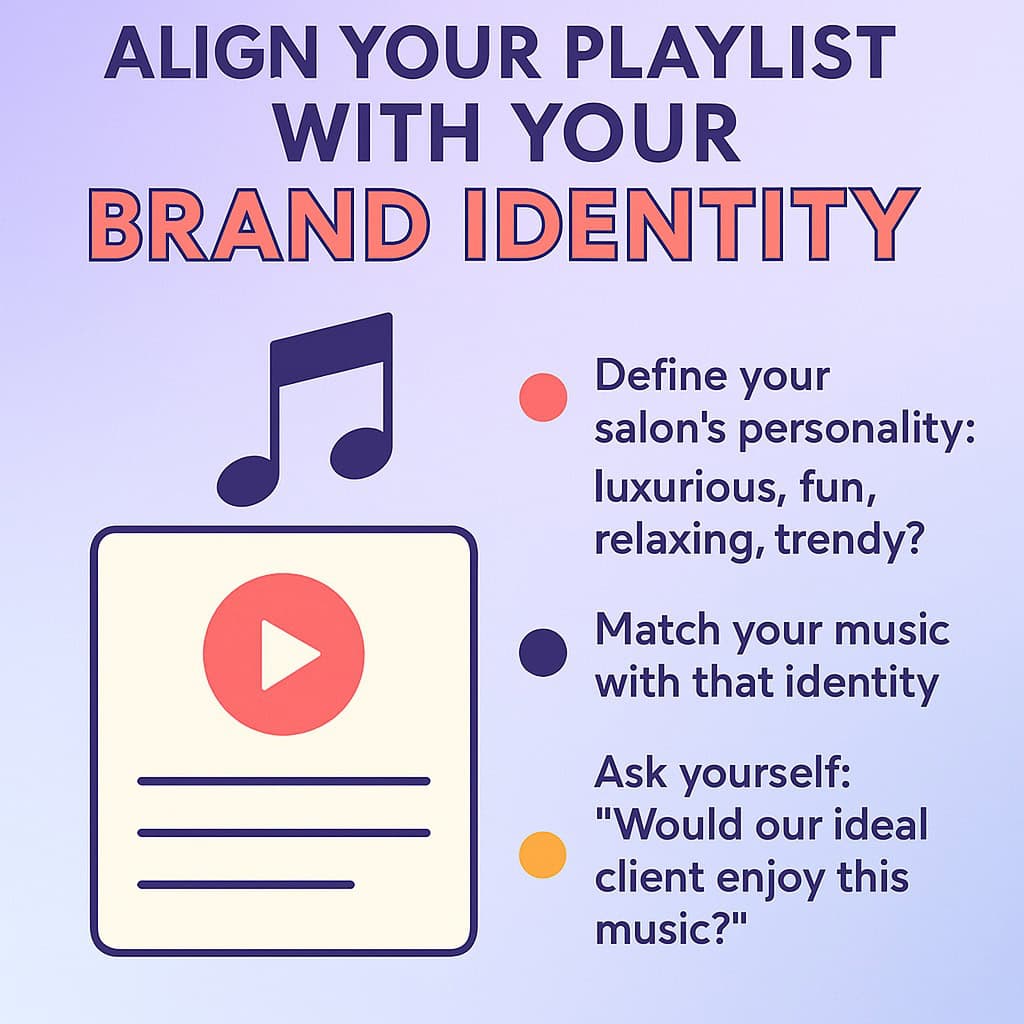
Align Your Playlist with Your Brand Identity
Now that we understand why music matters, let’s focus on what music to play. The crucial first step is aligning your playlist with your unique brand personality.
Think of it this way: if your salon were a person, what kind of music would they listen to? Answering this helps create an atmosphere that feels authentic and draws clients back.
Getting this wrong can be jarring for clients. As Kayle shares, “I’ve also been known to put on the wrong song… I’ve played songs that were too abrasive or too heavy or too loud, and people were not happy.”
To ensure your music resonates positively, follow these steps:
- Define your salon’s personality: Are you luxurious, fun, relaxing, trendy, or something else? Get specific about your core brand traits.
- Match your music to that identity. What genres, artists, or tempos embody those traits?
- Ask yourself: “Would our ideal client connect with this music?” Consider both their preferences and the mood you want to create for them.
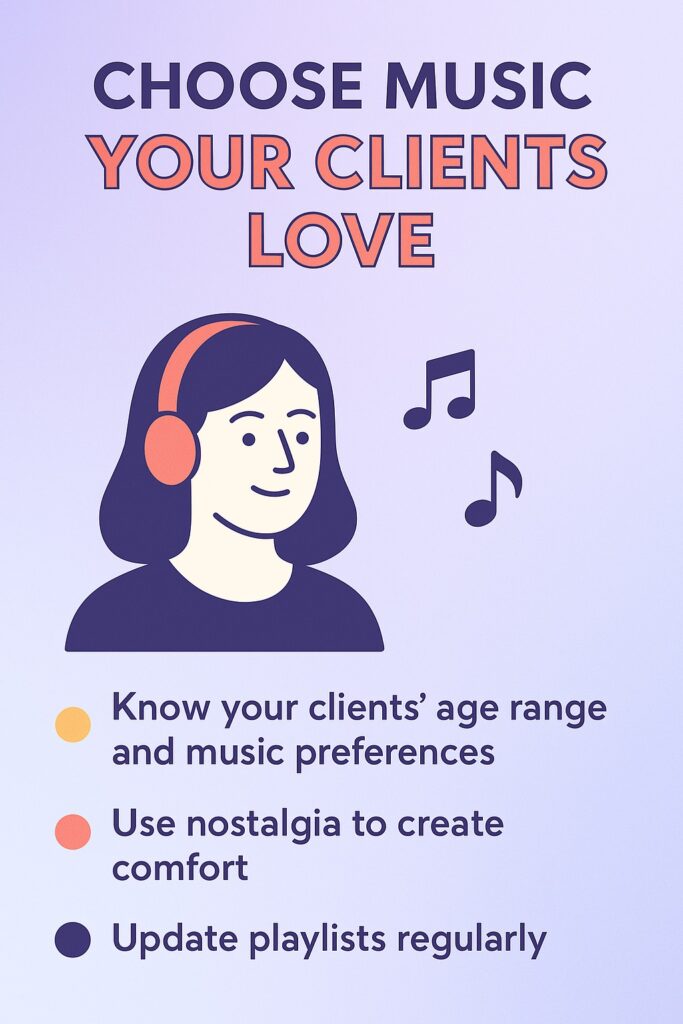
Choose Music Your Clients Love
While aligning with your brand is essential, truly effective salon music also resonates with your clients.
Understanding their preferences is the next layer in crafting the perfect playlist.
Are your clients primarily millennials nostalgic for early 2000s emo, or perhaps Gen Xers who’d appreciate some Depeche Mode and Duran Duran?
Targeting generational tastes can create powerful connections. For instance, a playlist featuring early 2000s emo might strike a fun, nostalgic chord with older millennial clients.
The key is tapping into the music that defined their formative years.
Tips for creating client-focused playlists:
- Know your clients’ age range and likely musical leanings. (Use Worksheet #2 from our resources!)
- Use nostalgia strategically. Music from their youth evokes powerful positive emotions.
- Update playlists regularly to keep things fresh for returning clients.
The science backs this up: research confirms that nostalgic music fosters a sense of belonging and connectedness (Lasaleta, 2014).
Playing music that resonates with your clients’ past helps forge stronger bonds between them and your salon, supporting effective client retention strategies.
↓ Pin it for Later ↓
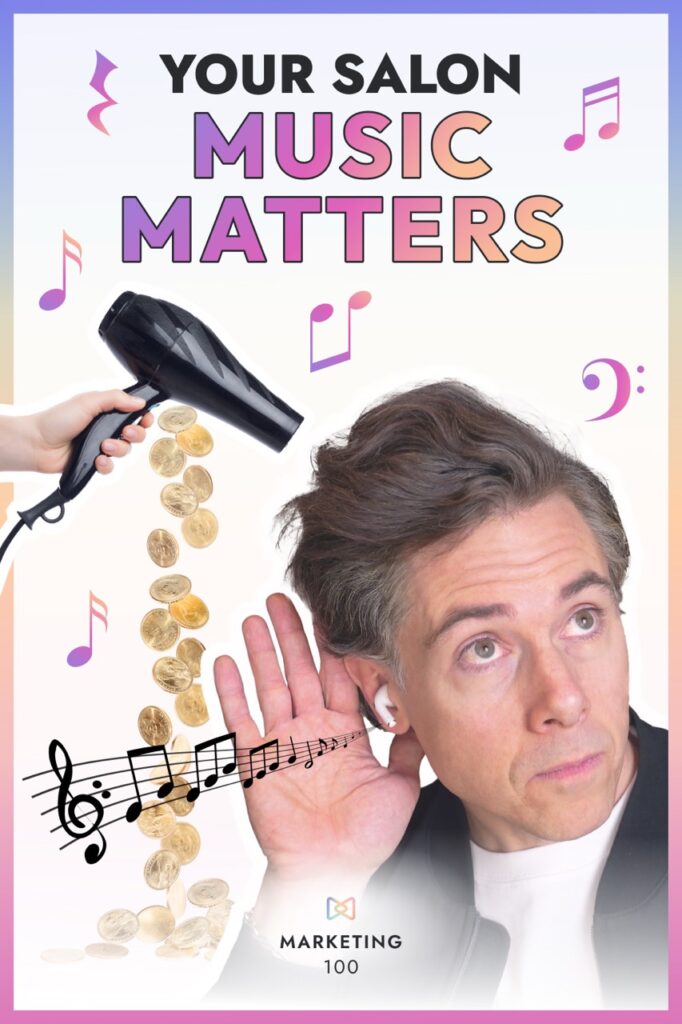
Balance Volume for Better Conversations
Choosing the right songs is only half the battle; controlling the volume is just as critical.
While gyms might crank up the energy with loud music, salons thrive on connection and conversation, requiring a more nuanced approach to volume.
Music that’s too loud destroys the relaxing atmosphere, hindering conversations between clients and stylists. This makes consultations difficult, impedes product recommendations, and can leave clients feeling stressed and eager to leave, the exact opposite of the desired effect.
Research confirms excessive volume can force people to raise their voices, make focusing harder, cause clients to leave sooner, and even reduce overall sales.
Simple Guidelines for Optimal Volume:
- Keep it conversation-friendly: The golden rule? Music should enhance, not impede, easy conversation. Clients and staff shouldn’t need to shout.
- Check in with clients and staff: Regularly ask how the volume feels to those in the space.
- Adjust for salon traffic and time of day. Slightly higher energy might work during peak hours, while quieter mornings or evenings call for lower volumes.
- Consider your clientele’s age: Remember that volume preferences vary by age. Younger clients might tolerate slightly higher levels, while older clients generally prefer softer volumes (Harrington, 2015).
The goal is to find that sweet spot: a volume audible enough to contribute positively to the atmosphere but never so loud that it creates stress or hinders connection.
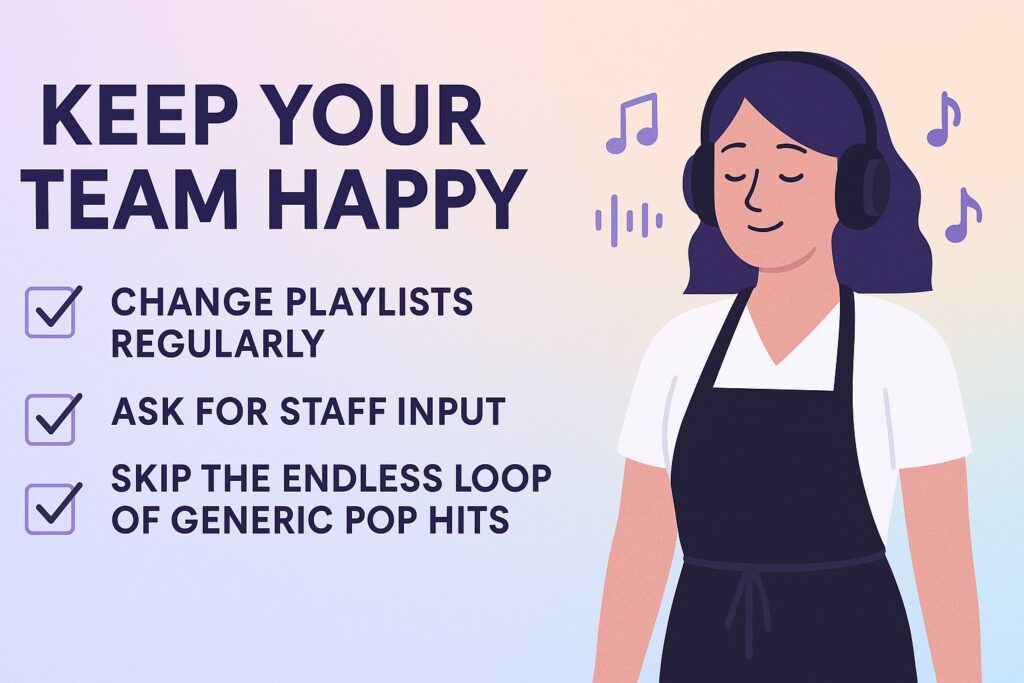
Keep Your Team Happy
While client experience is paramount, don’t forget the people who listen to your salon’s soundtrack all day, every day: your team. A poorly chosen or endlessly repetitive playlist can quickly lead to fatigue and frustration.
Consider your team; they need to hear this playlist day in and day out. Good, pleasant music enhances their mood and motivation.
The positive impact of workplace music is well-documented. Studies show the right background music can increase productivity, improve alertness, encourage team interaction, reduce stress, provide mental respite, make repetitive tasks less monotonous, strengthen team bonds, and even lead to fewer sick days (Haake, 2011).
Tips for Team-Friendly Playlists:
- Change playlists regularly. Variety is key to preventing auditory burnout.
- Ask for staff input. Involve your team in the selection process (Use Worksheet #3!).
- Skip the endless loop of generic pop hits. Aim for quality and diversity over predictability.
Avoid the dreaded “sonic wallpaper” effect—like the infamous “CVS Bangers” playlist Kayle mentions:
CVS Bangers is like if you’ve ever been to CVS pharmacy…every generic radio pop song from the ’90s. It’s terrible… all the worst music that you never wanted to hear again, and they just play it over and over… It shouldn’t be the kind of thing that makes their staff hate you.
The goal isn’t just to avoid annoying your staff, but to create a cohesive vibe that fits your salon culture, genuinely boosts morale, and contributes to building a strong salon culture. Regular updates are crucial for keeping the atmosphere fresh for everyone.
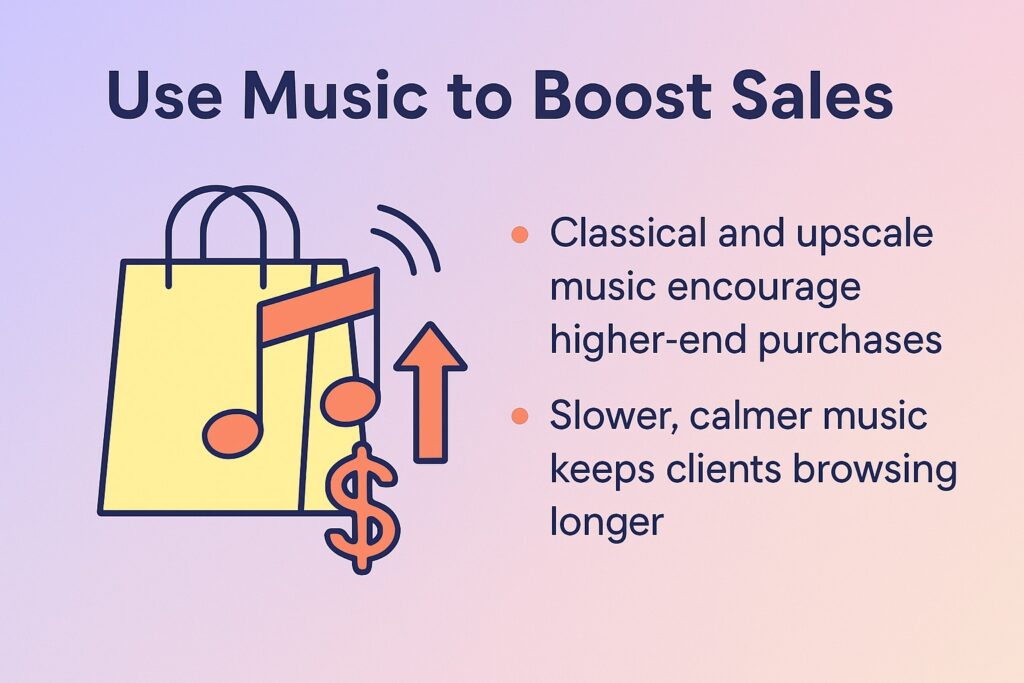
Use Music to Boost Sales
Your playlist affects what clients buy and how much they spend. The right music subtly influences purchasing decisions by shaping perceptions and altering behavior. Research shows:
Genre Matters for Price Perception: Classical and upscale music are linked to higher-end purchases. Playing classical music in retail environments tends to increase the amount of money shoppers are willing to spend, not necessarily by purchasing more items, but by opting for more expensive selections (Areni & Kim, 1993).
This is likely because these genres create an association with quality and sophistication, making clients more receptive to premium pricing.
Tempo Influences Browsing Time: Slower, calmer music keeps clients browsing longer. One study found that slow-tempo music can alter customers’ perception of time, making them feel less rushed and encouraging them to linger longer, which often leads to increased spending (Milliman, 1982).
More time spent browsing naturally creates more opportunities for impulse buys and add-on services.
Think strategically about the music in your retail area. If you want to move high-end products, lean towards sophisticated genres.
If you want clients to take their time exploring, opt for slower tempos. The key is aligning the sound with your sales goals, overall brand experience, and other tactics for boosting salon retail sales.
Music for Different Spaces
Not all areas of your salon have the same function or desired mood, so why should they have the same music?
Tailoring your soundtrack to specific zones can significantly enhance the client journey.
Businesses with separate rooms, like spas, have an advantage here, as they can easily customize the sound for each space.
For example, a calming, meditative track works perfectly in a massage room, while the reception or retail area might benefit from something slightly more upbeat.
Even in open-plan salons, thinking in terms of “zones” is beneficial. While one primary playlist might be necessary, its selection should consider the different activities happening – from relaxing treatments to lively styling and focused retail browsing.
This approach, sometimes called “music zoning,” is proven effective. Research confirms that music tailored to specific areas enhances the environment and can even lead to increased purchases (Oakes & North).
Consider these zone-specific strategies:
- Treatment rooms: Opt for soft, meditative music or nature sounds promoting deep relaxation.
- Styling stations: Use upbeat yet unobtrusive background tunes to maintain energy without hindering conversation.
- Waiting areas: Play calming music that welcomes and eases clients into their experience.
- Retail spaces: Select strategically chosen music (considering genre and tempo, per the sales section) that encourages browsing and aligns with product value.
Putting It All Together – Your Salon Soundtrack
As we’ve explored, the music you play in your salon is far more than just background filler. It’s a tool that actively shapes your brand perception, influences client behavior and spending, and impacts team morale.
By thoughtfully considering your brand identity, client demographics, volume levels, and zone-specific needs, you can transform your playlist from an afterthought into a powerful asset.
Key takeaways for crafting your perfect playlist:
- Be Authentic: Align music with your salon’s unique personality.
- Know Your Audience: Resonate with your clients’ generational tastes and preferences.
- Control the Volume: Enhance the atmosphere without hindering conversation.
- Keep it Fresh: Regularly update playlists to engage staff and returning clients.
- Be Strategic: Use genre and tempo to subtly influence browsing and purchasing.
- Think in Zones: Tailor music to specific areas like treatment rooms or retail spaces.
- Stay Legal: Ensure you have the proper licenses for playing music commercially.
🎵 Download Your Salon Music Strategy Worksheets
Ready to put these principles into action? Download our free, detailed worksheets to guide you step-by-step:
- Worksheet #1: Brand Identity Music Alignment
- Worksheet #2: Client Demographic Music Analysis
Music Licensing for Salons
One crucial detail often overlooked is music licensing. Playing copyrighted music publicly in your business, even from a personal Spotify or Apple Music account, requires specific commercial licenses.
Using personal accounts violates their terms of service and U.S. copyright law, potentially leading to hefty fines.
To stay compliant and avoid legal trouble, consider these options:
- Business-specific Music Services like Soundtrack Your Brand or Cloud Cover Music. These subscription services handle all the necessary licensing fees for you and often provide curated, brand-appropriate playlists.
- Direct Licensing with PROs (Performing Rights Organizations). You can obtain annual “blanket licenses” directly from organizations like ASCAP, BMI, and SESAC. This covers their respective catalogs but requires managing multiple licenses and fees.
- Royalty-free music services . These offer music specifically cleared for commercial use, often with a one-time or subscription fee, but the selection might be less familiar than popular hits.
Navigating licensing can seem complex, but it’s essential for protecting your business.
Want a clear breakdown of the rules, costs, and options?
🎵 Download our comprehensive Salon Music Licensing Compliance Checklist for everything you need to know.
P.S. For even more proven salon marketing tips, don’t forget to check out the rest of our Marketing 100 series.
